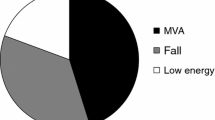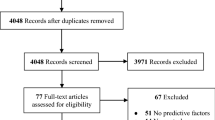Abstract
Trauma-associated acute compartment syndrome (ACS) of the extremities is a well-known complication in adults. There are only a handful of articles that describe the symptoms, the diagnostic procedure and treatment of ACS in children. The aim of this study was to analyse the diagnostic procedures in children compared to adolescents with ACS to obtain evidence for the diagnosis, treatment and outcome of children with ACS. Twenty-four children and adolescents with ACS have been treated at the Department of Trauma Surgery of the Medical University of Vienna, Austria. Two age-related groups were investigated to compare the diagnostic and therapeutic algorithm: group A comprising children aged 2–14 years (n = 12) and group B comprising adolescents aged 15–18 years (n = 12). Patient characteristics, diagnosis and therapy-associated data, complications and clinical outcome were analysed. In both groups we found fractures in most of our patients (n = 19) followed by contusion of the soft tissues (n = 3). In group A most of our patients were injured as pedestrians in car accidents (n = 5) followed by low-energy blunt trauma (n = 3). The most common region of injury and traumatic ACS was the lower leg (n = 7) followed by the feet (n = 3). For fracture stabilisation most of the patients (n = 6) received an external fixator. The mean time from admission to the fasciotomy was 27.9 hours. In four patients a compartment pressure measurement was performed with pressure levels from 30 to 75 mmHg. A histological examination of soft tissue was performed in five patients. From fasciotomy to definitive wound closure 2.4 operations were necessary. The mean hospital stay was 18.9 days. In group B most of our patients had a motorcycle accident (n = 5). The most common region for traumatic ACS in this group was also the lower leg (n = 9). In most of the patients (n = 6) intramedullary nails could be implanted. The mean time from admission to the fasciotomy was 27.1 hours. In six patients a compartment pressure measurement was performed with pressures from 25 to 90 mmHg. In five patients a histological examination was performed. From fasciotomy to definitive wound closure 2.3 operations were necessary. The mean hospital stay was 18.4 days. Secondary fasciotomy closure was performed in all cases. A split-skin graft was only necessary in three patients (13%). We avoided primary closure in the same setting when the fasciotomy was performed. Thus, we found no difference between the two groups in the diagnostic procedures, the indication for fasciotomy, the number of operations needed from fasciotomy to definitive wound closure, time of hospitalisation and clinical outcome. The rate of permanent complications was 4.2% (one patient from group A), which means that nearly all patients experienced full recovery after fasciotomy. ACS represents a surgical emergency and the indication should be determined early even in doubtful cases to avoid complications.

Similar content being viewed by others
References
Volkmann R (1881) Die ischaemischen Muskellähmungen und Kontrakturen. Centralbl Chir 8:801–803
Petersen F (1888) Ueber ischämische Muskellähmung. Arch Klin Chir 37:675–677
Paletta CE, Dehghan K (1994) Compartment syndrome in children. Ann Plast Surg 32:141–144
Elliott KG, Johnstone AJ (2003) Diagnosing acute compartment syndrome. J Bone Joint Surg Br 85:625–632
Martin JT (1992) Compartment syndromes: concepts and perspectives for the anesthesiologist. Anesth Analg 75:275–283
Lagerstrom CF, Reed RL 2nd, Rowlands BJ, Fischer RP (1989) Early fasciotomy for acute clinically evident posttraumatic compartment syndrome. Am J Surg 158:36–39
Mubarak SJ, Hargens AR (1983) Acute compartment syndromes. Surg Clin North Am 63:539–565
Hoffmeyer P, Cox JN, Fritschy D (1987) Ultrastructural modifications of muscle in three types of compartment syndrome. Int Orthop 11:53–59
Rorabeck CH (1984) The treatment of compartment syndromes of the leg. J Bone Joint Surg Br 66:93–97
Griffiths D (1951) Volkmann’s ischaemic contracture. J Bone Joint Surg Br 33:299–300
Tiwari A, Haq AI, Myint F, Hamilton G (2002) Acute compartment syndromes. Br J Surg 89:397–412
Ulmer T (2002) The clinical diagnosis of compartment syndrome of the lower leg: are clinical findings predictive of the disorder? J Orthop Trauma 16:572–577
Mubarak SJ, Owen CA, Hargens AR, Garetto LP, Akeson WH (1978) Acute compartment syndromes: diagnosis and treatment with the aid of the wick catheter. J Bone Joint Surg Am 60:1091–1095
Whitesides TE, Haney TC, Morimoto K, Harada H (1975) Tissue pressure measurements as a determinant for the need of fasciotomy. Clin Orthop Relat Res 113:43–51
Matsen FA 3rd, Winquist RA, Krugmire RB Jr (1980) Diagnosis and management of compartmental syndromes. J Bone Joint Surg Am 62:286–291
Schmidt AH (2007) Acute compartment syndrome. In: Stannard J (ed) Surgical treatment of orthopaedic trauma. Thieme, New York, pp 44–57
Gershuni DH, Yaru NC, Hargens AR, Lieber RL, O’Hara RC, Akeson WH (1984) Ankle and knee position as a factor modifying intracompartmental pressure in the human leg. J Bone Joint Surg Am 66:1415–1420
Staudt JM, Smeulders MJ, van der Horst CM (2008) Normal compartment pressures of the lower leg in children. J Bone Joint Surg Br 90:215–219
Strecker WB, Wood MB, Bieber EJ (1986) Compartment syndrome masked by epidural anesthesia for postoperative pain. Report of a case. J Bone Joint Surg Am 68:1447–1448
Morrow BC, Mawhinney IN, Elliott JR (1994) Tibial compartment syndrome complicating closed femoral nailing: diagnosis delayed by an epidural analgesic technique–case report. J Trauma 37:867–868
Johnson DJ, Chalkiadis GA (2009) Does epidural analgesia delay the diagnosis of lower limb compartment syndrome in children? Paediatr Anaesth 19:83–91
Mubarak SJ, Hargens AR, Owen CA, Garetto LP, Akeson WH (1976) The wick catheter technique for measurement of intramuscular pressure. A new research and clinical tool. J Bone Joint Surg Am 58:1016–1020
Whitesides TE Jr, Haney TC, Harada H, Holmes HE, Morimoto K (1975) A simple method for tissue pressure determination. Arch Surg 110:1311–1313
Matsen FA 3rd, Mayo KA, Sheridan GW, Krugmire RB Jr (1976) Monitoring of intramuscular pressure. Surgery 79:702–709
Barnes MR, Gibson MJ, Scott J, Bentley S, Allen MJ (1985) A technique for the long term measurement of intra-compartmental pressure in the lower leg. J Biomed Eng 7:35–39
Awbrey BJ, Sienkiewicz PS, Mankin HJ (1988) Chronic exercise-induced compartment pressure elevation measured with a miniaturized fluid pressure monitor. A laboratory and clinical study. Am J Sports Med 16:610–615
Gentilello LM, Sanzone A, Wang L, Liu PY, Robinson L (2001) Near-infrared spectroscopy versus compartment pressure for the diagnosis of lower extremity compartmental syndrome using electromyography-determined measurements of neuromuscular function. J Trauma 51:1–8, discussion 8–9
Garr JL, Gentilello LM, Cole PA, Mock CN, Matsen FA 3rd (1999) Monitoring for compartmental syndrome using near-infrared spectroscopy: a noninvasive, continuous, transcutaneous monitoring technique. J Trauma 46:613–616, discussion 617–618
Mubarak SJ, Owen CA (1977) Double-incision fasciotomy of the leg for decompression in compartment syndromes. J Bone Joint Surg Am 59:184–187
Due J Jr, Nordstrand K (1987) A simple technique for subcutaneous fasciotomy. Acta Chir Scand 153:521–522
Berman SS, Schilling JD, McIntyre KE, Hunter GC, Bernhard VM (1994) Shoelace technique for delayed primary closure of fasciotomies. Am J Surg 167:435–436
Sheridan GW, Matsen FA 3rd (1976) Fasciotomy in the treatment of the acute compartment syndrome. J Bone Joint Surg Am 58:112–115
Rush DS, Frame SB, Bell RM, Berg EE, Kerstein MD, Haynes JL (1989) Does open fasciotomy contribute to morbidity and mortality after acute lower extremity ischemia and revascularization? J Vasc Surg 10:343–350
Conflict of interest
No benefits in any form have been received or will be received from a commercial party related directly or indirectly to the subject of this article.
Author information
Authors and Affiliations
Corresponding author
Rights and permissions
About this article
Cite this article
Erdös, J., Dlaska, C., Szatmary, P. et al. Acute compartment syndrome in children: a case series in 24 patients and review of the literature. International Orthopaedics (SICOT) 35, 569–575 (2011). https://doi.org/10.1007/s00264-010-1016-6
Received:
Revised:
Accepted:
Published:
Issue Date:
DOI: https://doi.org/10.1007/s00264-010-1016-6




